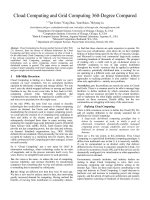360 degree feedback sample questionnaire


Đánh giá nhân viên: Phương pháp 360 độ
Ngày tải lên :
21/08/2012, 18:02
... Đánh giá nhân viên: Phương pháp 360 độ Nhật An dịhc từ Elitnui Personal
Làm thế nào để đánh giá nhân viên một cách khách quan mà ... đầu những năm 90 tại các nước Tây âu hình thành một phương
pháp đánh giá nhân viên với tên gọi: 360 độ. Và nếu cứ theo cái tên gọi này thì các nhà
quản trị nhân lực đã nghĩ tới tất cả các khía ... cũng khác với điểm năm.
Ngay từ những giai đoạn đầu tiên của việc hình thành phương pháp đánh giá 360 này
người ta thường quen với hình thức các bảng câu hỏi hay các brochure. Người ta điền vào...
- 3
- 11K
- 136

One-Sample Estimation Problems (TOÁN)
Ngày tải lên :
12/09/2012, 16:20
... Chương 6:
One -Sample
Estimation Problems
Giảng viên: Nguyễn Phương
Contents
Introduction
Point Estimation
Interval Estimation
Single Sample: Estimating the Mean
Single Sample: Estimating ... n;
à
(0;1)
/
X
N
S n
à
;
/2 /2
1P X z X z
n n
à
≤ ≤ + = −
Single Sample: Estimating the Mean
Single Sample: Estimating the Mean
Từ bảng trên, ta tính được:
2
17
15.1176( )
4.2353
2.0580( ... à
à à
= =
= =
=
= − − −
= − − − − + −
= − − −
∑ ∑
∑ ∑
∑
Single Sample: Estimating a Proportion
Single Sample: Estimating the Mean
Ta có 1-α=0.99
Tra bảng ta được:
Khoảng...
- 36
- 783
- 0

AC R Sample Task Type 1 Task
Ngày tải lên :
04/10/2012, 09:39
... Sample task type 1
[Note: This is an extract from an Academic Reading passage on the subject of
government subsidies to farmers. The text preceding this extract explained how
subsidies can lead to activities which cause uneconomical and irreversible changes
to the environment.]
All these activities may have damaging environmental impacts. For example, land clearing
for agriculture is the largest single cause of deforestation; chemical fertilisers and pesticides
may contaminate water supplies; more intensive farming and the abandonment of fallow
periods tend to exacerbate soil erosion; and the spread of monoculture and use of high
yielding varieties of crops have been accompanied by the disappearance of old varieties of
food plants which might have provided some insurance against pests or diseases in future.
Soil erosion threatens the productivity of land in both rich and poor countries. The United
States, where the most careful measurements have been done, discovered in 1982 that
about onefifth of its farmland was losing topsoil at a rate likely to diminish the soil's
productivity. The country subsequently embarked upon a program to convert 11 per cent of
its cropped land to meadow or forest. Topsoil in India and China is vanishing much faster
than in America.
Government policies have frequently compounded the environmental damage that farming
can cause. In the rich countries, subsidies for growing crops and price supports for farm
output drive up the price of land. The annual value of these subsidies is immense: about
$250 billion, or more than all World Bank lending in the 1980s. To increase the output of
crops per acre, a farmer's easiest option is to use more of the most readily available inputs:
fertilisers and pesticides. Fertiliser use doubled in Denmark in the period 19601985 and
increased in The Netherlands by 150 per cent. The quantity of pesticides applied has risen
too: by 69 per cent in 19751984 in Denmark, for example, with a rise of 115 per cent in the
frequency of application in the three years from 1981.
In the late 1980s and early 1990s some efforts were made to reduce farm subsidies. The
most dramatic example was that of New Zealand, which scrapped most farm support in
1984. A study of the environmental effects, conducted in 1993, found that the end of
fertiliser subsidies had been followed by a fall in fertiliser use (a fall compounded by the
decline in world commodity prices, which cut farm incomes). The removal of subsidies also
stopped landclearing and overstocking, which in the past had been the principal causes of
erosion. Farms began to diversify. The one kind of subsidy whose removal appeared to
have been bad for the environment was the subsidy to manage soil erosion.
... Sample task type 1
[Note: This is an extract from an Academic Reading passage on the subject of
government subsidies to farmers. The text preceding this extract explained how
subsidies can lead to activities which cause uneconomical and irreversible changes
to the environment.]
All these activities may have damaging environmental impacts. For example, land clearing
for agriculture is the largest single cause of deforestation; chemical fertilisers and pesticides
may contaminate water supplies; more intensive farming and the abandonment of fallow
periods tend to exacerbate soil erosion; and the spread of monoculture and use of high
yielding varieties of crops have been accompanied by the disappearance of old varieties of
food plants which might have provided some insurance against pests or diseases in future.
Soil erosion threatens the productivity of land in both rich and poor countries. The United
States, where the most careful measurements have been done, discovered in 1982 that
about onefifth of its farmland was losing topsoil at a rate likely to diminish the soil's
productivity. The country subsequently embarked upon a program to convert 11 per cent of
its cropped land to meadow or forest. Topsoil in India and China is vanishing much faster
than in America.
Government policies have frequently compounded the environmental damage that farming
can cause. In the rich countries, subsidies for growing crops and price supports for farm
output drive up the price of land. The annual value of these subsidies is immense: about
$250 billion, or more than all World Bank lending in the 1980s. To increase the output of
crops per acre, a farmer's easiest option is to use more of the most readily available inputs:
fertilisers and pesticides. Fertiliser use doubled in Denmark in the period 19601985 and
increased in The Netherlands by 150 per cent. The quantity of pesticides applied has risen
too: by 69 per cent in 19751984 in Denmark, for example, with a rise of 115 per cent in the
frequency of application in the three years from 1981.
In the late 1980s and early 1990s some efforts were made to reduce farm subsidies. The
most dramatic example was that of New Zealand, which scrapped most farm support in
1984. A study of the environmental effects, conducted in 1993, found that the end of
fertiliser subsidies had been followed by a fall in fertiliser use (a fall compounded by the
decline in world commodity prices, which cut farm incomes). The removal of subsidies also
stopped landclearing and overstocking, which in the past had been the principal causes of
erosion. Farms began to diversify. The one kind of subsidy whose removal appeared to
have been bad for the environment was the subsidy to manage soil erosion.
Sample task type 1
Questions 10 – 12
Choose the appropriate letters A, B, C or D.
Write your answers in boxes 1012 on your answer sheet.
10 ...
- 3
- 625
- 0

AC R Sample Task Type 4 Task
Ngày tải lên :
04/10/2012, 09:39
... Sample task type 4
[Note: This is an extract from an Academic Reading passage on the subject of dung
beetles. The text preceding this extract gave some background facts about dung
beetles, and went on to describe a decision to introduce nonnative varieties to
Australia.]...
- 2
- 672
- 0

Writing sample task 1A
Ngày tải lên :
04/10/2012, 09:39
... successful.
Academic Writing Sample Task 2B
Sample Script A
Academic Writing Sample Task 2A
Sample Script A
Academic Writing Sample Task 1B
Sample Script B
... Academic Writing Sample Task 1A
Sample Script A
Examiner comment
Band 5
The length ... forms, tense and voice and occasionally the text becomes incoherent.
Academic Writing Sample Task 1A
Sample Script B
Examiner comment
Band 6
The candidate has made a good attempt...
- 13
- 1.3K
- 1

Brain Friendly Publiscations Who Are You Intermediate Questionnaires
Ngày tải lên :
05/10/2012, 08:20
... of the questionnaire and pre-teach some relevant vocabulary. Key lexical items are printed in
italics in the questionnaires and also listed on the back inside cover.
3. Distribute the questionnaires ... themselves, which is why questionnaires are so irresistible. They also provide an ideal
means of stimulating conversation, especially as a lead-in to a new topic.
The 20 questionnaires presented ... small groups of three or four. Give a questionnaire to one student only in the group. Set a time limit.
Allow longer than for Method 1.
4. The student with the questionnaire is the interviewer. He/she...
- 25
- 1.1K
- 2



An action research on the use of continuous feedback to improve the first year students' pronunciation at the english department, college of foreign languages, vietnam national university, hanoi part 2
Ngày tải lên :
07/11/2012, 14:58
... forms of corrective feedback in the class: peer feedback from
other students, and teacher’s feedback.
* Out-of-class feedback
Beside in-class feedback, the teacher required the students to attend ... of feedback brought to them, so they were eager to come and did their task
seriously.
3.5.2 Feedback types
Three types of feedback were exploited during the research.
The first type of feedback ... their speech to provide
corrective feedback.
Despite the inevitable importance of feedback, there have been very few researches
focusing on the use of feedback to improve students’ performance....
- 76
- 1.1K
- 2








